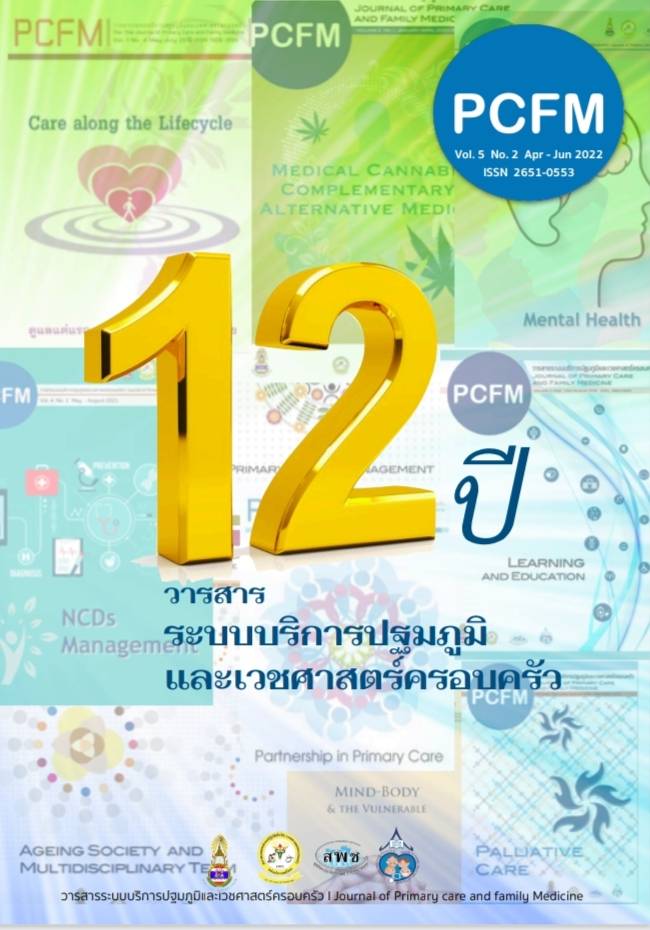ประสิทธิผลของโปรแกรมการดูแลผู้ป่วยโรคไตเรื้อรังแบบบูรณาการต่อการชะลอภาวะไตเสื่อม
Main Article Content
บทคัดย่อ
ประสิทธิผลของโปรแกรมการดูแลผู้ป่วยโรคไตเรื้อรังแบบบูรณาการต่อการชะลอภาวะไตเสื่อม
บทคัดย่อ
ที่มา: โรคไตเรื้อรังเป็นปัญหาสุขภาพที่สำคัญทั่วโลกรวมทั้งประเทศไทย ผู้ป่วยส่วนใหญ่มาตรวจรักษาเมื่อเป็นโรคไตวายระยะสุดท้ายซึ่งต้องใช้การรักษาแบบบำบัดทดแทนไตที่มีค่าใช้จ่ายสูงมาก ส่งผลกระทบต่อครอบครัวจนถึงระดับประเทศ
รูปแบบและวัตถุประสงค์: งานวิจัยนี้เป็นการวิจัยกึ่งทดลอง(quasi-experimental study) เพื่อศึกษาประสิทธิผลของโปรแกรมการดูแลผู้ป่วยโรคไตเรื้อรังแบบบูรณาการต่อการชะลอภาวะไตเสื่อม กลุ่มตัวอย่างคือ ผู้ป่วยโรคไตเรื้อรังระยะที่ 3 และ 4 จำนวน135คน ในเขตพื้นที่โรงพยาบาลส่งเสริมสุขภาพตำบล(รพสต.) 4 แห่งในอำเภอเมือง จังหวัดสงขลา ตั้งแต่วันที่ 1 กุมภาพันธ์ 2563 ถึง 31 มีนาคม 2564
วัสดุและวิธีการ: เครื่องมือที่ใช้เป็นโปรแกรมการดูแลผู้ป่วยโรคไตเรื้อรังแบบบูรณาการ ประกอบด้วย การอบรมอาสาสมัครสาธารณสุข และผู้ดูแลผู้ป่วย การจัดตั้งคลินิกโรคไตเรื้อรังที่รพสต. และการเยี่ยมบ้านผู้ป่วย ใช้แบบบันทึกข้อมูลและแบบสัมภาษณ์พฤติกรรมการจัดการตนเองเพื่อชะลอไตเสื่อม วิเคราะห์ข้อมูลโดยใช้สถิติShapiro-Wilk normality test, Paired t-test, Wilcoxon signed-rank test, Student’s t-test และWilcoxon rank sum test
ผลการศึกษา: กลุ่มทดลองมีค่าเฉลี่ยระดับความดันโลหิต(systolic blood pressure)ลดลงกว่ากลุ่มควบคุมอย่างมีนัยสำคัญทางสถิติ(P=0.016) และมีค่าเฉลี่ยคะแนนพฤติกรรมการจัดการตนเองเพื่อชะลอไตเสื่อมเพิ่มขึ้นกว่ากลุ่มควบคุมอย่างมีนัยสำคัญทางสถิติ(P<0.001) กลุ่มทดลองมีค่าเฉลี่ย eGFR เพิ่มขึ้นในรอบ 1 ปี (0.4 ml/min/1.73 m2 / year) ในขณะที่กลุ่มควบคุมมีค่าเฉลี่ยeGFRลดลงในรอบ 1 ปี (-1.3 ml/min/1.73m2/year) แต่ไม่มีความแตกต่างกันอย่างมีนัยสำคัญทางสถิติ(P=0.514)
คำสำคัญ: โรคไตเรื้อรัง การชะลอภาวะไตเสื่อม โรงพยาบาลส่งเสริมสุขภาพตำบล โปรแกรมการดูแลผู้ป่วยโรคไตเรื้อรังแบบบูรณาการ
Article Details

อนุญาตภายใต้เงื่อนไข Creative Commons Attribution-NonCommercial-NoDerivatives 4.0 International License.
เนื้อหาและข้อมูลในบทความที่ลงตีพิมพ์ในวารสาร PCFM ถือเป็นข้อคิดเห็นและความรับผิดชอบของผู้เขียนบทความโดยตรง ซึ่งกองบรรณาธิการวารสารไม่จำเป็นต้องเห็นด้วยหรือร่วมรับผิดชอบใด ๆ
บทความ ข้อมูล เนื้อหา รูปภาพ ฯลฯ ที่ได้รับการตีพิมพ์ลงในวารสาร PCFM ถือเป็นลิขสิทธิ์ของวารสาร PCFM หากบุคคลหรือหน่วยงานใดต้องการนำทั้งหมดหรือส่วนหนึ่งส่วนใดไปเผยแพร่ต่อหรือเพื่อกระทำการใด ๆ จะต้องได้รับอนุญาตเป็นลายลักษณ์อักษรจากวารสาร PCFM ก่อนเท่านั้น
เอกสารอ้างอิง
Zhang QL, Rothenbacher D. Prevalence of chronic kidney disease in population-based studies. systematic review. BMC Public heath [internet]. 2008 [cited 2011 Jul 20]; 8:117. Available from: http://www.biomedcentral.com/1471-2458/8/117
สมาคมโรคไตแห่งประเทศไทย. แนวทางเวชปฏิบัติสำหรับโรคไตเรื้อรังก่อนการบำบัดทดแทนไต พ.ศ. 2552. กรุงเทพมหานคร : สมาคมโรคไตแห่งประเทศไทย ; 2552.
สมาคมโรคไตแห่งประเทศไทย. คำแนะนำสำหรับการดูแลผู้ป่วยโรคไตเรื้อรังก่อนการบำบัดทดแทนไต พ.ศ.2558 กรุงเทพมหานคร: สมาคมโรคไตแห่งประเทศไทย; 2558.
สำนักงานหลักประกันสุขภาพแห่งชาติ. คู่มือบริหารงบกองทุนหลักประกันสุขภาพแห่งชาติ 2554 : การบริหารงบบริการสุขภาพผู้ป่วยไตวายเรื้อรัง. กรุงเทพมหานคร:ศรีเมืองการพิมพ์; 2554.
Department of Disease Control. Clinic practice guidelines: CKD. Ministry of Public Health 2015; 1-59.
Nygardh A, Wikby K, Malm D, Ahlstrom G. Empowerment in outpatient care for patients with chronic kidney disease-from the family member’s perspective. BMC Nursing 2011; 10: 21.
Friedman MM. Family Nursing: Research, Theory and Practice 5th ed. New Jersey: Upper Saddle River; 2003.
Suparatangool S. The family patterns of response to slowing the rate of decline in kidney function in chronic kidney disease patients. Disease Control Journal 2018; 44(1):92-101.
Jiamjariyaporn T, Ingsathit A, Tungsanga K, Banchein C, Vipattawat K, Karchanakorn S, et al. Effectiveness of integrated care on delaying chronic kidney disease progression in rural communities of Thailand (ESCORT study): rationale and design of the study. BMC Nephrology [internet].2014 [cited 2016 Jun 13]; 15:2-7. Available from: http://www.biomedcentral.com/1471-2369/15/99.
Leesmidt V, Suwattanarak S, Promnim S, Pannarunothai S. A study for delaying kidney deterioration of chronic kidney disease patients of Khlongkhlung hospital: From research to practice. Journal of Health Science 2017;26(1):111-124.
Kevesdy CP, Funth SL, Zoccali C. Obesity and kidney disease: Hidden consequences of the epidemic. Kidney Disease 2017; 3(1):33-41.
Awdishu L, Mehta R. The 6R’s of drug induced nephrotoxicity. BMC Nephrology 2017; 18:124.
Levey AS, De Jong PE, Coresh J, et al. The definition, classification, and prognosis of chronic kidney disease: a KDIGO Controversies Conference report. Kidney Int 2010; 80:17.
Kidney Disease: Improving Global Outcomes (KDIGO) CKD Work Group. KDIGO 2012 clinical practice guideline for the evaluation and management of chronic kidney disease. Kidney Int Supply 2013;3(1):73-90.
KDIGO BP Work Group. KDIGO clinical practice guideline for the management of blood pressure in chronic kidney disease. Kidney inter., Suppl. 2012; 2: 363-369.
Thungtong S, Effects of self-management support program for delayed progression of diabetic nephropathy on self-management behaviors and clinical outcomes in patients with uncontrolled type 2 diabetes mellitus. Songkhla: Prince of Songkhla University; 2014
Kankarn W. Holistic nursing in CAPD patients: Challenge role under PD first police. Journal of Nursing and Health Care 2015; 33(4): 6-14.
Sutheeraprasert P, Kankarn W. The effectiveness of encourage family and village health volunteers participation program to delayed the progression of chronic kidney disease in urban area of Khon Kaen province. Journal of Nursing and Health Care 2018; 36(4):42-51.
Virojanakud N. Effects of knowledge development self-management and participation of caregiver program on level of plasma fasting glucose and delayed progression of diabetic nephropathy in patients with uncontrolled type2 diabetic mellitus. Region11 Medical Journal 2018; 31(1): 41-48.
Sangwatthanayuth P, Watthanakorn K, Klinhom K, Ratanapat P. Effects of family and village health volunteer participation program on health promoting behaviors, and blood pressure in pre-hypertension adults. Veridian E-Journal, Science and Technology Silpakorn University 2016; (3):1-14.
โรจกร ลือมงคล. ปัจจัยที่สัมพันธ์กับพฤติกรรมการดูแลตนเองของผู้ป่วยโรคไตเรื้อรังในโรงพยาบาลคอนสวรรค์. วารสารสำนักงานป้องกันควบคุมโรคที่10 2563; 18(1):16-26.
ชณิตา สุริอาจ, ปรีย์กมล รัชนกุล, วนลดา ทองใบ. การรับรู้ภาวะสุขภาพ พฤติกรรรมการดูแลสุขภาพ และความต้องการการบริการสุขภาพของผู้ต้องขังที่มีความผิดปกติทางเมตาบอลิก. รามาธิบดีพยาบาลสาร 2557; 20(3): 372-387.
Chriss PM, Sheposh J, Carlson B, et al. Predictors of successful heart failure self-care maintenance in the first three months after hospitalization. Heart and Lung 2004; 33(6): 345-353.
ภทรพรรณ อุณาภาค, ขวัญชัย รัตนมณี. ปัจจัยที่มีความสัมพันธ์กับพฤติกรรมการดูแลตนเองเพื่อป้องกันภาวะแทรกซ้อนทางไตของโรงพยาบาลสมเด็จพระพุทธเลิศหล้า จังหวัดสมุทรสงคราม. วารสารสาธารณสุข มหาวิทยาลัยบูรพา 2558; 10(2): 44-54.
Skinner CS, Tiro J, Champion VL. The health belief model. Health behavior: theory, research, and practice 5th ed. San Francisco: Jossey-Bass; 2015;75-94.
Rosenstock IM. Historical origins of the health belief model. Health Education Monographs 1974; 2(4): 328-335.
สุปราณี กิติพิมพ์, วันเพ็ญ ภิญโญภาสกุล, อรวมน ศรียุกตศุทธ. ปัจจัยทำนายพฤติกรรมสร้างเสริมสุขภาพในผู้ป่วยโรคไตเรื้อรังระยะแรกและระยะปานกลาง. วารสารพยาบาล 2556; 62(4): 35-42.
Patel A, MacMahon S, Chalmers J et al. Effects of a fixed combination of perindopril and indapamide on macrovascular and microvascular outcomes in patients with type2 diabetes mellitus (the ADVANCE trial): a randomised controlled trial. Lancet 2007; 370:829-840.
de Galan BE, Perkovic V, Ninomiya T et al. Lowering blood pressure reduces renal events in type2 diabetes. J Am Soc Nephrol 2009; 20:883-892.
Heerspink HJ, Ninomiya T, Perkovic V et al. Effects of fixed combination of perindopril and indapamide in patients with type2 diabetes and chronic kidney disease. Euro Heart J 2010; 31:2888-2896.
Bayliss EA, Bhardwaja B, Ross C, Beck A, Lanese DM. Multidisciplinary team care may slow the rate of decline in renal function. Clin J AM Soc Nephrol. 2011; 6(4): 704-710.
สำนักโรคไม่ติดต่อ กรมควบคุมโรค กระทรวงสาธารณสุข. คู่มือปฏิบัติการเพื่อดำเนินงานลดโรคไตเรื้อรังCKDในผู้ป่วยเบาหวานและความดันโลหิตสูง. พิมพ์ครั้งที่1. กรุงเทพมหานคร: โรงพิมพ์องค์การสงเคราะห์ทหารผ่านศึก;2559;31-40.
Rossing P, Rossing K, Gaede P, Pedersen O, Parving HH. Monitoring kidney function in type 2 diabetic patients with incipient and overt diabetic nephropathy. Diabetic Care 2006; 29(5):1024-1030.
ไพศาล ไตรสิริโชค, หลั่งพร อุตรศาสตร์, วราทิพย์ แก่นการ. ผลของการสนับสนุนการจัดการตนเองโดยทีมสหสาขาวิชาชีพเพื่อชะลอโรคไตเรื้อรังในหน่วยบริการปฐมภูมิโรงพยาบาลศูนย์ขอนแก่น.ศรีนครินทร์เวชสาร 2562; 34(6): 552-8
สมคิด สุภาพันธ์. การพัฒนารูปแบบการชะลอไตเสื่อมในผู้ป่วยโรคเบาหวานและโรคความดันโลหิตสูงด้วยการจัดการรายกรณี โรงพยาบาลภูสิงห์ จังหวัดศรีสะเกษ. วารสารวิชาการสาธารณสุข 2562; 28(5): 857-66.
Suwanwaha S, Wonghongkul T, Panuthai S, Chaiard J. Effectiveness of Self-Management Enhancement Program for Thais with CKD at Pre-dialysis Stages: A Randomized Controlled Trial. Pacific Rim Int J Nurse Res 2016; 20(4): 320-36.


